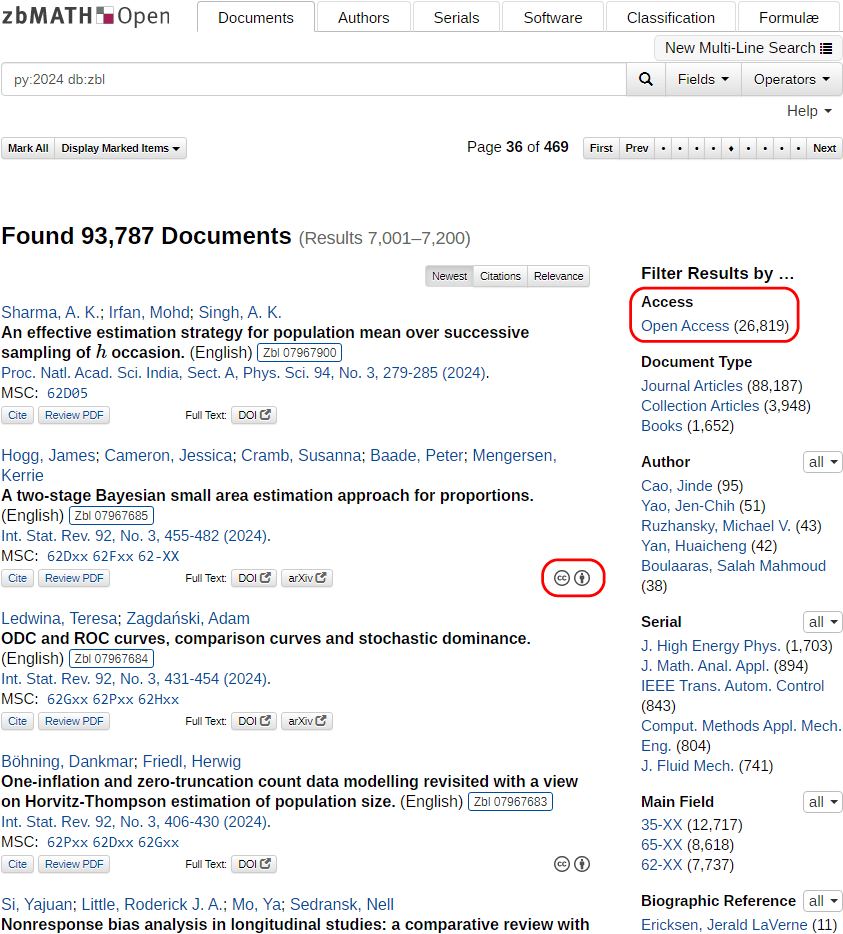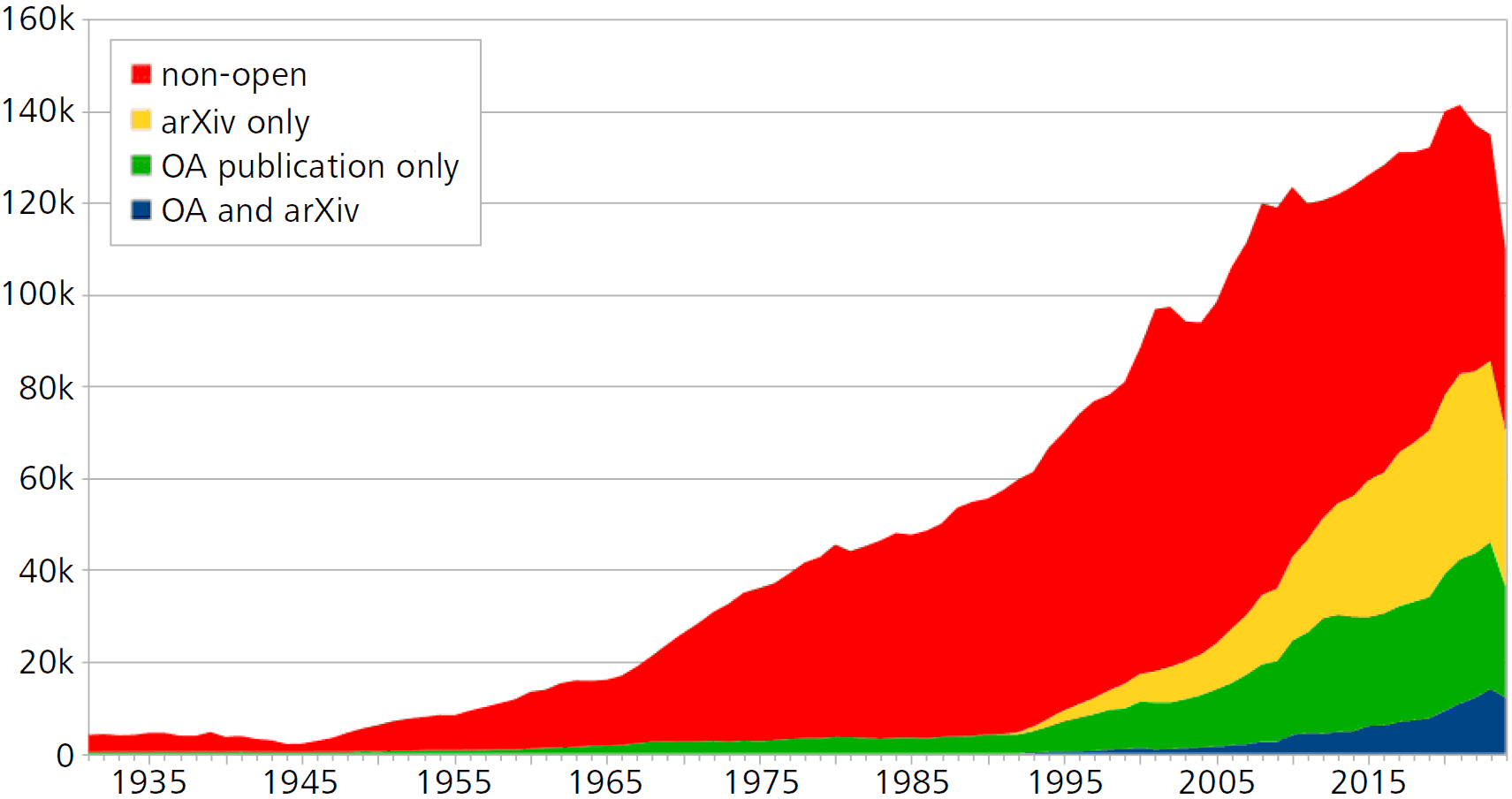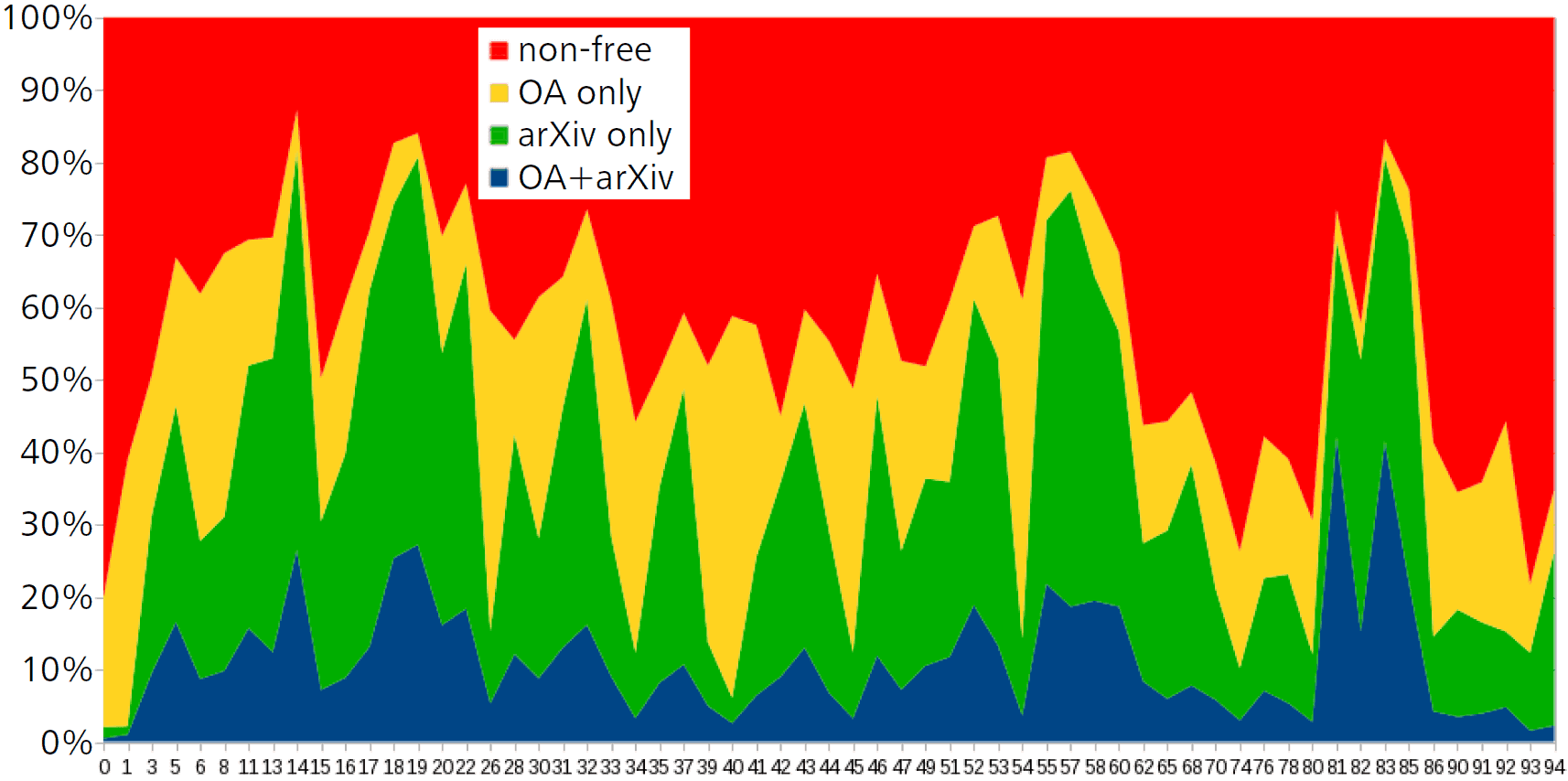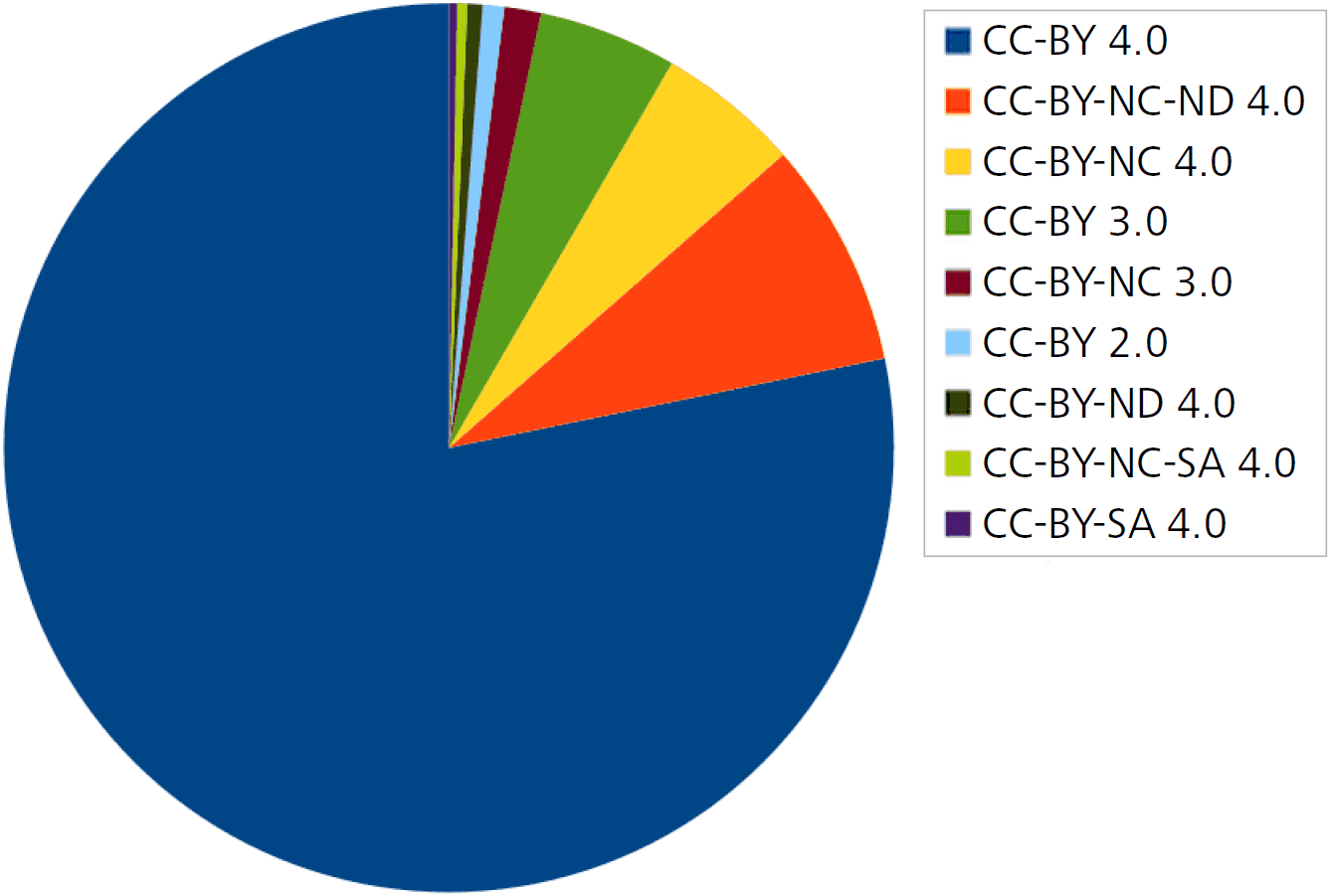Since December 2024, zbMATH Open displays open access and licence information not just on a journal level but also for individual articles. We give some examples how the feature can be employed in an analysis of the publication landscape in mathematics.
1 Introduction
For several years, zbMATH has included information about open access policies in its journals database1Currently, https://zbmath.org/serials/?q=st:o lists more than 1000 mathematics journals which employ various general OA policies.. However, the number of journals with a mixed situation has grown recently, due to the increased presence of hybrid access (e.g., due to APC2Article processing charge. options, transformative agreements, or as a result of subscribe-to-open policies). Moreover, also for non-OA publications an open version may exist (e.g., on the arXiv). Therefore, it is beneficial to have OA information also available at the document level, not just as journal policies.
Moreover, it becomes increasingly important that publications are not just openly accessible but come along with an open licence such as CC-BY3Creative Commons Attribution 4.0 International Licence, https://creativecommons.org/licenses/by/4.0/.. The licence situation is also quite diverse – e.g., older arXiv submissions generally come just with a non-exclusive distribution licence, while broader CC licences are more frequently available for recent documents. Hence, a lot of effort has been made to collect both OA and licence data in zbMATH Open, enabling document level information.
2 OA and licence information in zbMATH Open
Open access information at zbMATH is collected from a large variety of sources. For journals with a homogeneous OA policy, the information is derived from the zbMATH Open journaldatabase4For some OA journals without stable document identifiers, it may even happen that there is no direct full-text link to an open full-text article, but one needs to go via the journal homepage.. For hybrid journals, access and licence information is often provided by the publishers. Additional information is gathered from sources like OpenAlex, Unpaywall, the arXiv, or HAL. Especially, the integration of the arXiv (both by the matching of published documents to their arXiv versions, and the inclusion of unpublished maths preprints, see [1 I. Beckenbach, K. Hulek and O. Teschke, The extension of zbMATH Open by arXiv preprints. Eur. Math. Soc. Mag. 131, 54–58 (2024) ]) adds a significant number of open items.
The results are retrievable using the “open access” search and filter option in zbMATH Open. Additionally, an open licence information is displayed if available. This will look as follows:
Moreover, the data are also available via the zbMATH Open API [5 M. Petrera, F. Müller and M. Schubotz, API solutions at zbMATH Open. In 90 years of zbMATH, pp. 55–73, European Mathematical Society (EMS), Berlin (2024) , 6 M. Petrera, D. Trautwein, I. Beckenbach, D. Ehsani, F. Müller, O. Teschke, B. Gipp and M. Schubotz, zbMATH Open: API solutions and research challenges. In Proc. DISCO 2021, pp. 4–13 (2021) , 7 M. Schubotz and O. Teschke, zbMATH Open: Towards standardized machine interfaces to expose bibliographic metadata. Eur. Math. Soc. Mag. 119, 50–53 (2021) ]. In the next section, we give an application to use them for an update of our investigation [2 D. Ehsani and O. Teschke, On the road to a comprehensive open digital mathematics library. Eur. Math. Soc. Newsl. 118, 76–78 (2020) ] on the progress of open access in mathematics.
3 Share of open available mathematics
In [2 D. Ehsani and O. Teschke, On the road to a comprehensive open digital mathematics library. Eur. Math. Soc. Newsl. 118, 76–78 (2020) ], we gave a detailed overview of the (then) main forms of open access in mathematics. The most significant developments during the past five years pertain to hybrid open access (propelled also by transformative publish-and-read agreements) and S2O5Subscribe to Open policies. The following diagram displays the share of OA versions of articles indexed in zbMATH Open published in a given year since 1931, for genuine OA documents, existing free versions at the arXiv, and documents freely available by both options.6Data are available through the zbMATH Open API https://api.zbmath.org/.
The first observation is that only quite recently (in fact, since 2021) the share of free documents surpassed the 50% mark. While this had been achieved in several core areas of mathematics by arXiv coverage alone for some years (see [3 F. Müller and O. Teschke, Will all mathematics be on the arXiv (soon)? Eur. Math. Soc. Newsl. 99, 55–57 (2016) , 4 F. Müller and O. Teschke, Progress of self-archiving within the DML corpus, with a view toward community dynamics. In Intelligent Computer Mathematics, Lecture Notes in Comput. Sci. 9791, pp. 63–74, Springer, Cham (2016) ]), this figure indicates that OA policies have been adopted also by mathematical fields that were less present at the arXiv before.
The second observation is that the growing share of open documents is mostly driven by available arXiv versions. In fact, both the share of articles solely available free on the arXiv, and of genuine OA publications with an arXiv version, has increased – but the second one much more significantly: while the share of genuine OA publications with an arXiv version was hovering around 5% ten years ago, it has been tripled since then. On the other hand, the share of genuine OA publications not available on arXiv has actually slightly decreased. Initially, that seems quite surprising – does this mean that the implementation of policies like transformative agreements and S2O has actually been offset by an increased engagement of arXiv submissions, to an extent that they did not achieve much to increase the overall OA share?
In fact, zbMATH allows for a closer look via its journal filters and data to explore the stagnating figures of sole OA publications. The journal distribution of this kind of publication has changed significantly: Around 2013, when the share of OA publications not on arXiv peaked at 18%, it was dominated by the relatively new journals with an APC policy (“Gold Open Access”). However, in the course of the next years, in a number of these journals a significant content degradation became visible, perhaps also triggered by the effect that APCs create incentives for quantitative publishing (see [8 O. Teschke, Green, gold, platinum, nickel: On the status of open access in mathematics. Eur. Math. Soc. Newsl. 110, 60–63 (2018) ] for a detailed discussion). This resulted in discontinued indexing of several APC journals in zbMATH Open (in fact, some of these were delisted later also from other services amid concerns of problematic behaviour7See, e.g., https://retractionwatch.com/2023/03/21/nearly-20-hindawi-journals-delisted-from-leading-index-amid-concerns-of-papermill-activity/.).
On the other hand, recently, genuine OA articles not at the arXiv appear much more frequently in hybrid journals, often subject to transformative agreements of funding requirements. So indeed there has been an effect of the OA policies, mostly in areas where the usage of the arXiv is not yet widespread. The following diagram indicates the distribution of the four segments with respect to the Mathematical Subject Classification.
Overall, this diagram mainly reflects the different degree of arXiv usage of the different communities. While arXiv submissions are standard in most fields, its usage is less widespread for applications of mathematics (except for mathematical physics) and numerical analysis. Moreover, a significant fraction of publications is made open through S2O, transformative agreements, or moving walls. On the other hand, as discussed in [8 O. Teschke, Green, gold, platinum, nickel: On the status of open access in mathematics. Eur. Math. Soc. Newsl. 110, 60–63 (2018) ], one observes still a prevalence of non-arXiv OA in a few areas where communities with a more quantitative publication attitude exist (e.g., fractional analysis in 26, 34, 35, fixed point theorems in 47, 54, fuzzy structures in 06, 08, 26, 54, or classes of functions or sequence spaces in 30, 33, 40). The prevalence of Gold OA in only some very specific fields may raise further questions about whether the Gold Open Access approach (either through APCs, or transformative agreements) leads to a desirable allocation of resources.
4 Open licences
Free access to a publication has been the most pressing concern in the past, but the issue of open licences has become increasingly important as well. This is especially true since data have become highly valuable, and the FAIR principles (findability, accessibility, interoperability, reusability) became relevant also for mathematics content. For instance, with the advent of generative AI, there is already a clear tendency that paywalled scientific content is used to create commercial oligopolies of some large AI firms. While open licences may hardly prevent the usage of mathematics content in generative AI services (even though CC-BY-ND or CC-BY-SA licences might not be compatible with how most AI services are currently trained and distributed, experience indicates that the legal requirements are ignored by large companies anyway), they offer at least the option to create smaller, community-driven non-commercial services which might be more tailored to specific needs.
Naturally, these questions have only become important relatively recently, so it is not surprising that only a fraction of the free documents in zbMATH Open come also along with a FAIR licence (e.g., most historical arXiv submissions come with a non-exclusive distribution licences, although also CC licences are now available for some years). Figure 4 shows the current share of various CC licence information collected for documents in zbMATH Open from various sources (publishers, platforms, OpenAlex…), but are currently available for only about 5% of the entries.
5 Conclusion
The entire mathematics community can benefit from the availability of OA documents. zbMATH Open will contribute to the process by collecting information regarding the open access policies of journals as well as individual documents. The mathematics community can contribute by making available OA preprints via a preprint server whenever possible, and choosing an appropriate non-restrictive open access licence (e.g., CC-BY). The granular information provided by zbMATH Open on OA policies and licences, both through its web interface and APIs, offers options for a detailed analysis of the availability of resources, and the evaluation of the different OA strategies.
- 1
Currently, https://zbmath.org/serials/?q=st:o lists more than 1000 mathematics journals which employ various general OA policies.
- 2
Article processing charge.
- 3
Creative Commons Attribution 4.0 International Licence, https://creativecommons.org/licenses/by/4.0/.
- 4
For some OA journals without stable document identifiers, it may even happen that there is no direct full-text link to an open full-text article, but one needs to go via the journal homepage.
- 5
Subscribe to Open
- 6
Data are available through the zbMATH Open API https://api.zbmath.org/.
- 7
References
- I. Beckenbach, K. Hulek and O. Teschke, The extension of zbMATH Open by arXiv preprints. Eur. Math. Soc. Mag. 131, 54–58 (2024)
- D. Ehsani and O. Teschke, On the road to a comprehensive open digital mathematics library. Eur. Math. Soc. Newsl. 118, 76–78 (2020)
- F. Müller and O. Teschke, Will all mathematics be on the arXiv (soon)? Eur. Math. Soc. Newsl. 99, 55–57 (2016)
- F. Müller and O. Teschke, Progress of self-archiving within the DML corpus, with a view toward community dynamics. In Intelligent Computer Mathematics, Lecture Notes in Comput. Sci. 9791, pp. 63–74, Springer, Cham (2016)
- M. Petrera, F. Müller and M. Schubotz, API solutions at zbMATH Open. In 90 years of zbMATH, pp. 55–73, European Mathematical Society (EMS), Berlin (2024)
- M. Petrera, D. Trautwein, I. Beckenbach, D. Ehsani, F. Müller, O. Teschke, B. Gipp and M. Schubotz, zbMATH Open: API solutions and research challenges. In Proc. DISCO 2021, pp. 4–13 (2021)
- M. Schubotz and O. Teschke, zbMATH Open: Towards standardized machine interfaces to expose bibliographic metadata. Eur. Math. Soc. Mag. 119, 50–53 (2021)
- O. Teschke, Green, gold, platinum, nickel: On the status of open access in mathematics. Eur. Math. Soc. Newsl. 110, 60–63 (2018)
Cite this article
Dariush Ehsani, Olaf Teschke, Open access status and licences in zbMATH Open. Eur. Math. Soc. Mag. 135 (2025), pp. 61–64
DOI 10.4171/MAG/241



